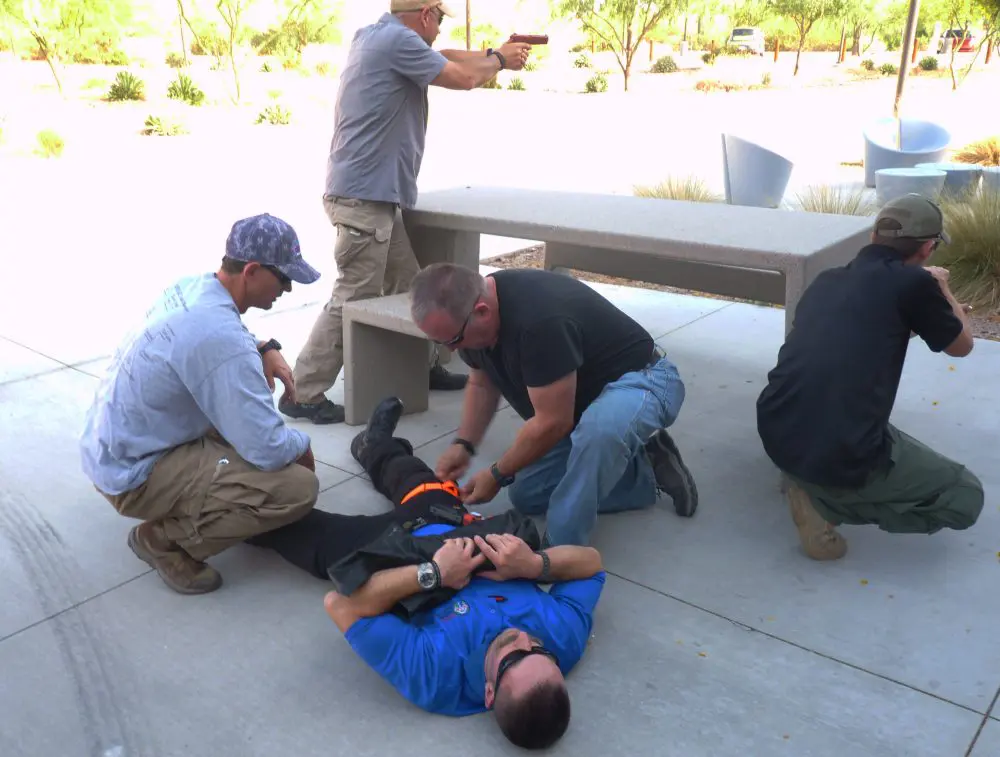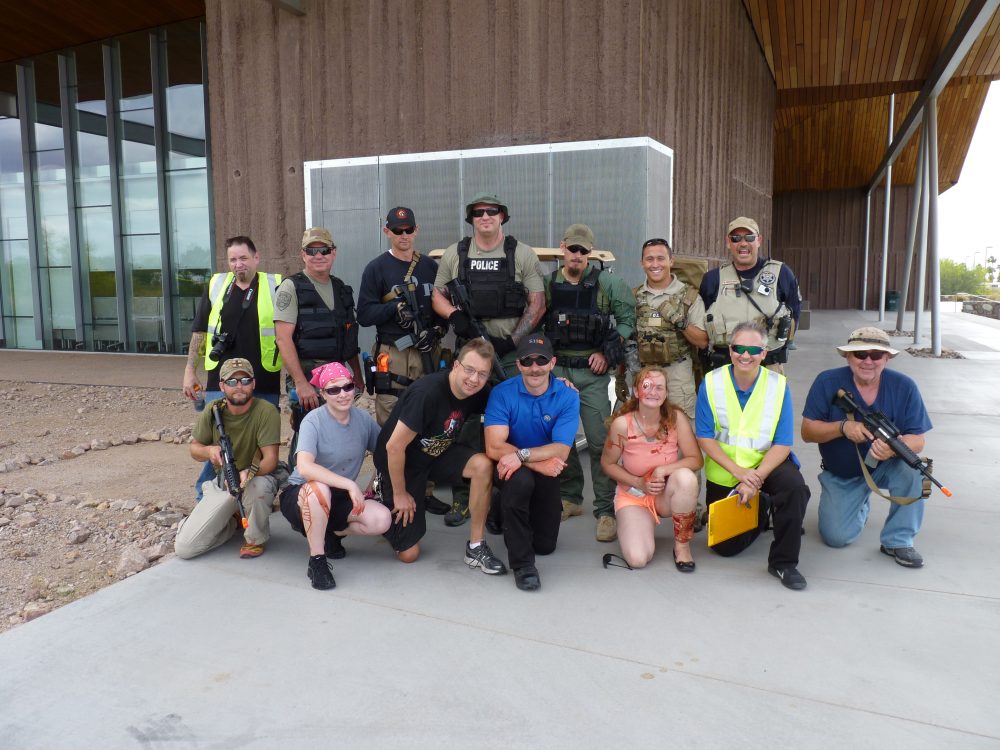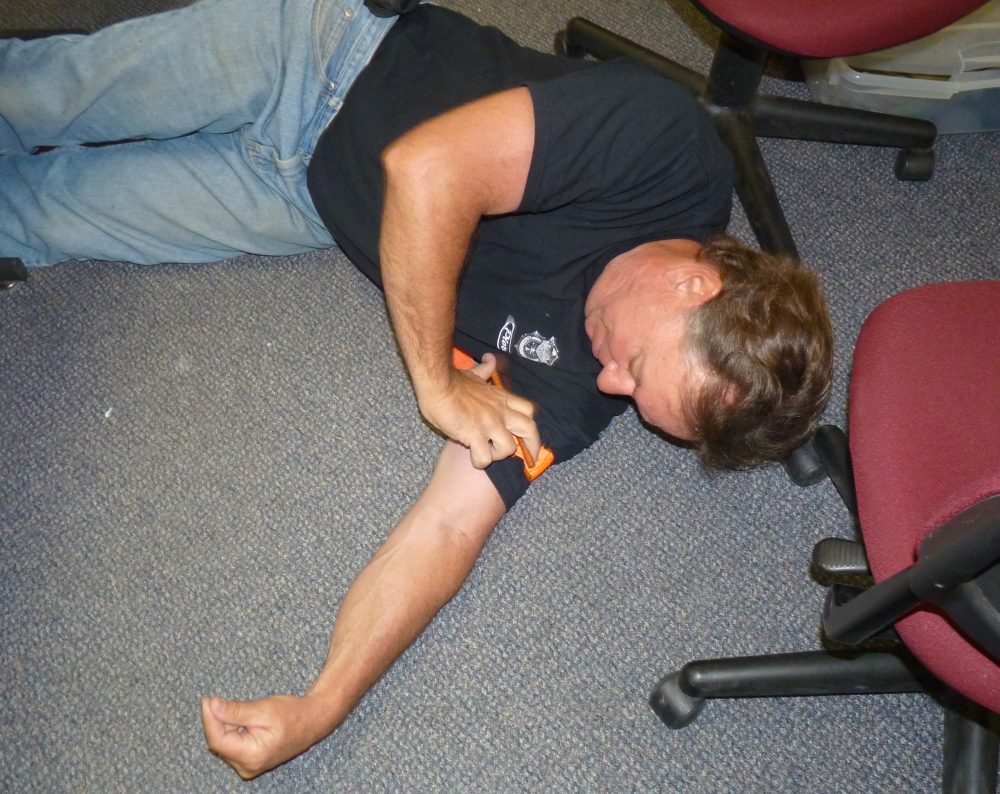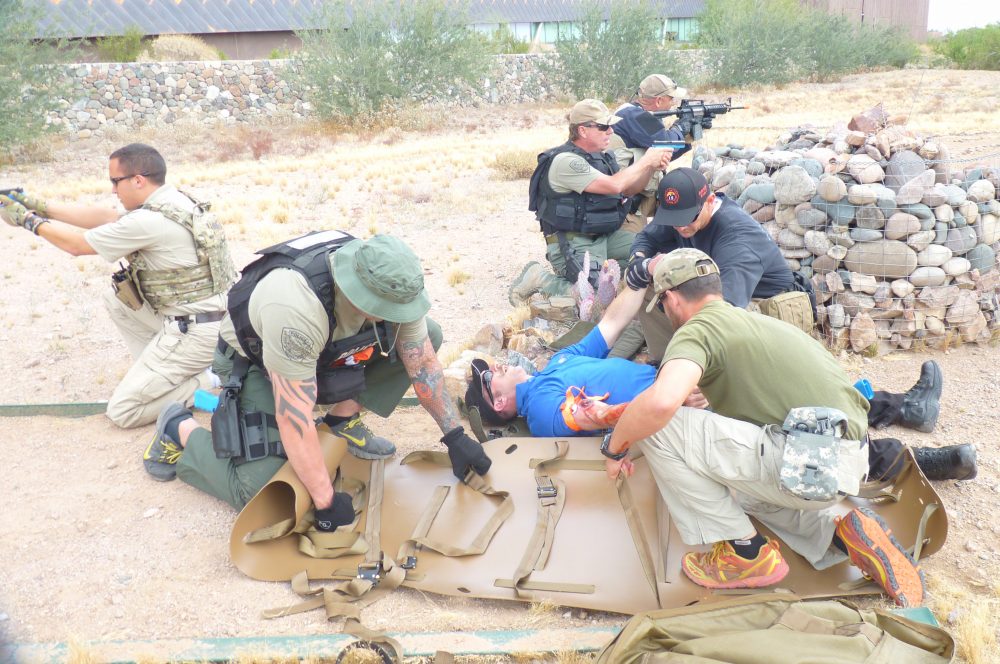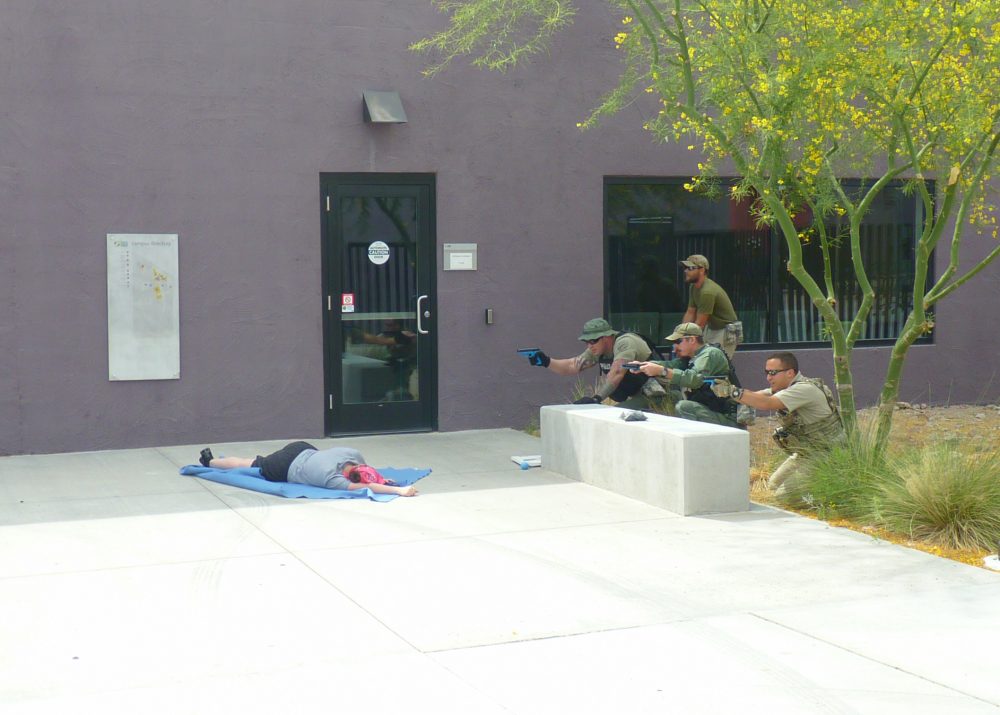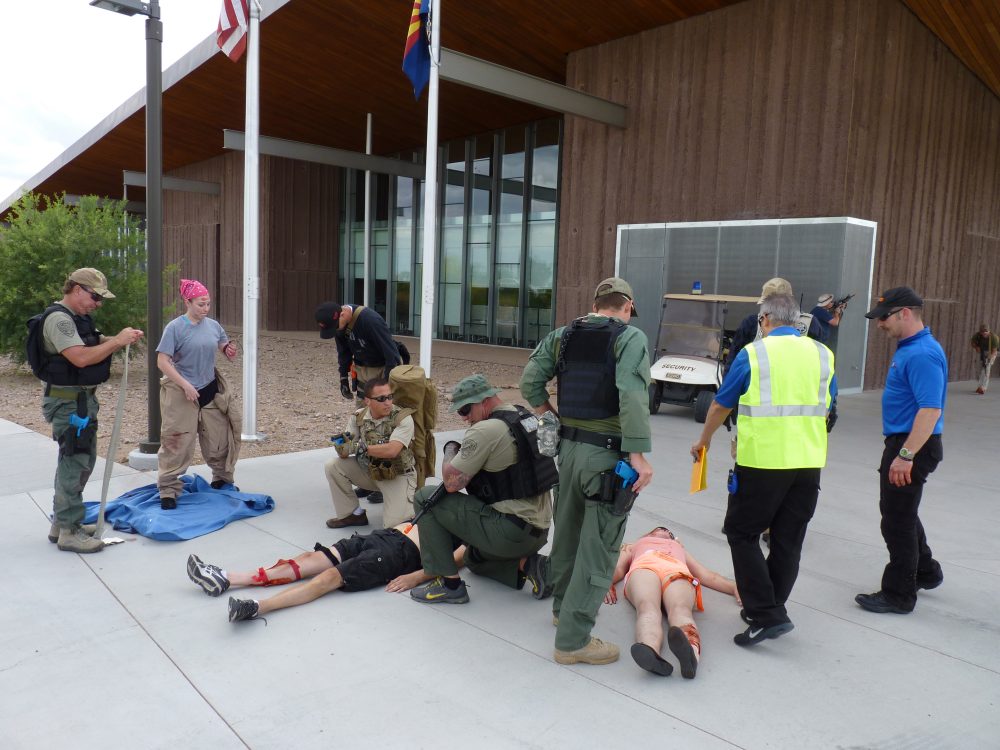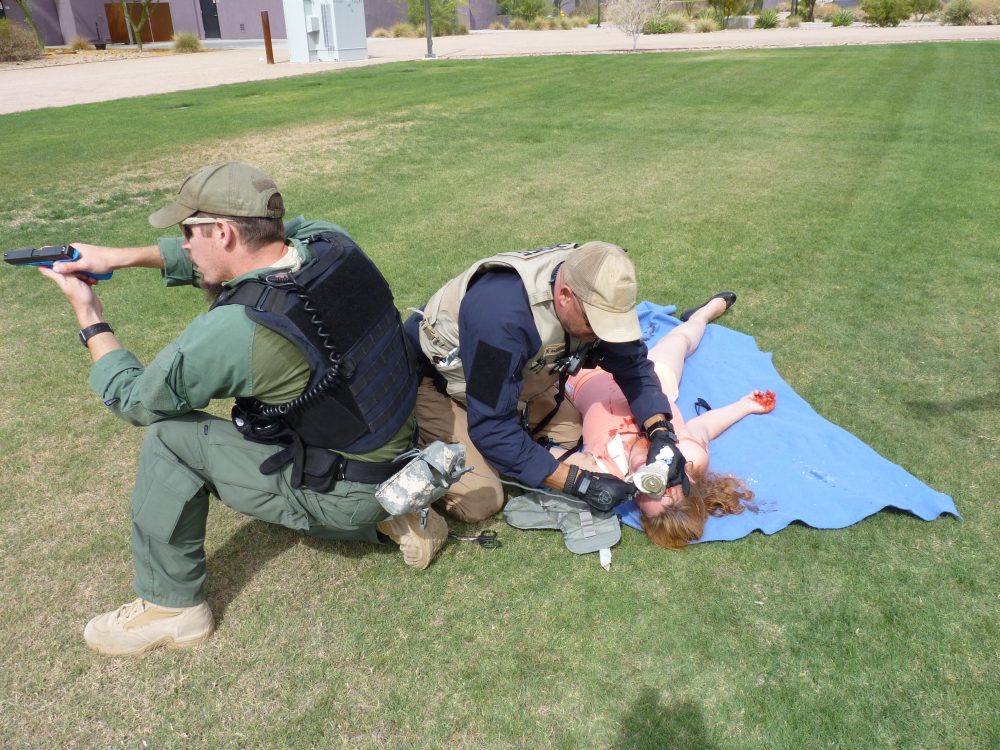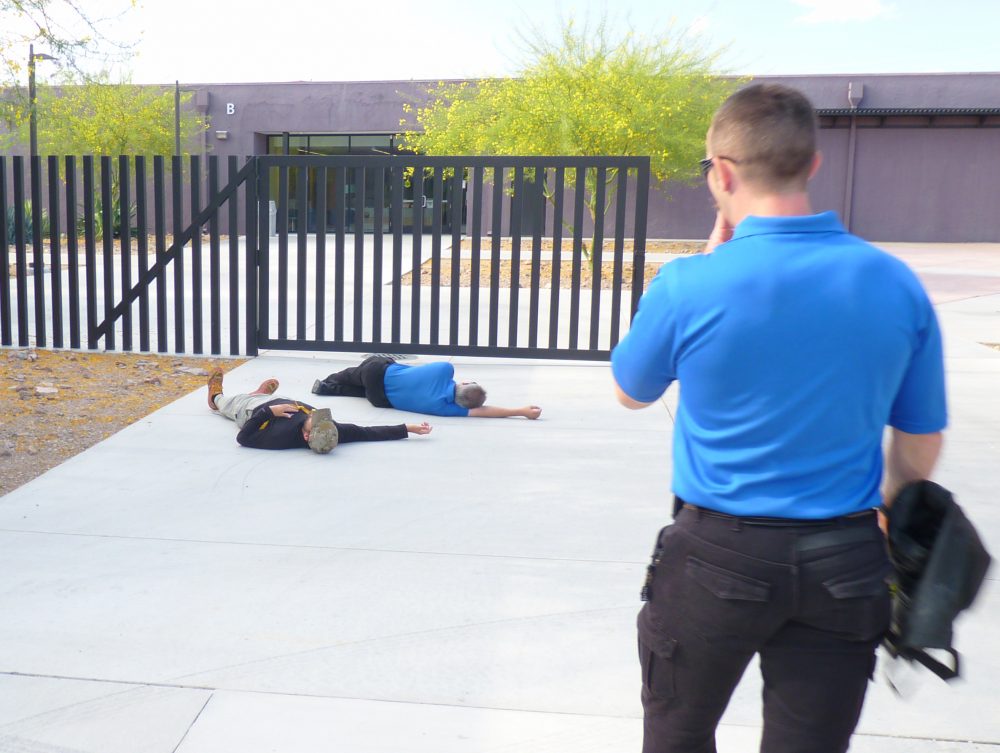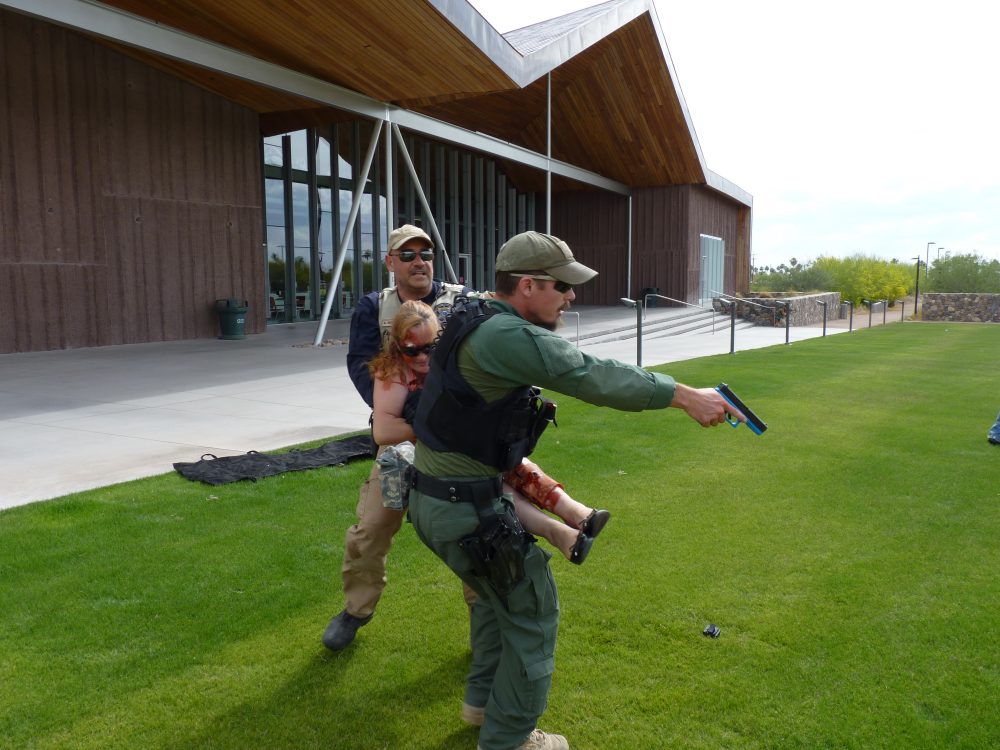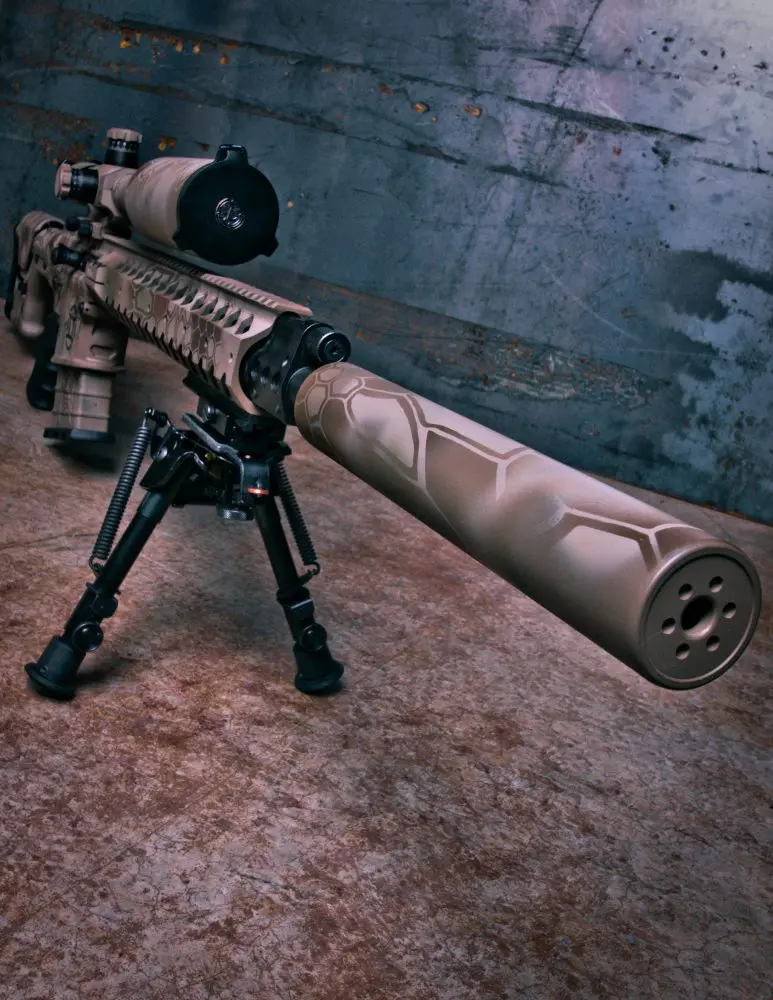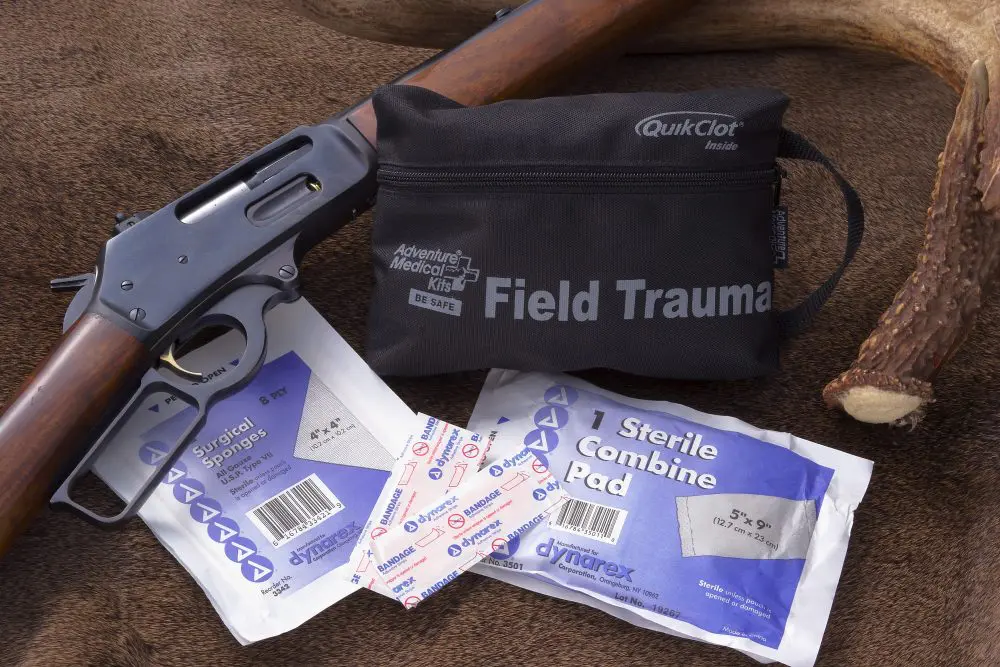Learning is the only pleasure of which there is no surfeit.
-Col. John Dean “Jeff” Cooper
If you’re a shooter, a gunshot wound is as real a possibility as a negligent discharge. One hopes it never happens, but it can. Now what? How can we help? How can we avoid doing further harm? It was time for me to expand my training beyond making effective hits.
I attended a course in Tactical Combat Casualty Care given by the fine people at Tactical Support Institute of Mesa, Arizona. I am now able to do a great many things to preserve a life in the critical first minutes after a serious injury. I recommend this training to everyone who regularly carries a weapon or goes into harm’s way. Today, TCCC is taught to every soldier.
TCCC class with victims and faculty.
After registering, I was told to obtain the textbook, PreHospital Trauma Life Support and take a pre-test based on the course work. TSI is serious. They want you to prepare for this class.
Tactical medicine has existed since the first rock was thrown in anger: Treat the casualty, prevent additional casualties, and complete the mission.
In 2001 the U.S. Special Operations Command created the Committee on Tactical Combat Casualty Care. All CoTCCC members are medical professionals with at least one deployment. CoTCCC developed a series of protocols that are easy to understand and administer and can be effectively deployed by the average trooper and unit medic.
The Committee first analyzed casualty figures from the Vietnam War. The vast majority of deaths occurred due to hemorrhage, tension pneumothorax (sucking chest wound), and airway problems. Using TCCC protocols, combat deaths today are 9.7% of what they were in the Vietnam War. That is a huge improvement in survivability.
Students apply a tourniquet during Tactical Field Care phase.
TACTICAL SUPPORT INSTITUTE
Mark Warren, the leader of Tactical Support Institute, and his staff members Tim Freund and Chris Shivley offer TCCC training in the southwest. Mark is a former police officer who decided to cross-train as an EMT. Chris helps Mark administer the business, while Tim (a SWAT medic) and others serve TSI as the training cadre. Active-duty U.S. military medics, SWAT medics, and other emergency services people serve as adjunct instructors.
TSI’s people are extremely well qualified. So were our students. Among them were firefighters, Army nurses, combat medics, LE personnel, and a helicopter medic. All of them had taken this training before. I was the only “newbie” in the crowd.
The days of unarmed medics wearing a red cross are over. Today, a medic fights with his unit, and over the two days I saw excellent tactics and strategy superimposed over effective life-saving skills.
Instructor Tim Freund distributed red training guns and training tourniquets to all students. We evaluated various designs, but the Combat Application Tourniquet was favored because it can easily be applied using one hand.
Student applies training tourniquet in class.
Once considered the treatment of last resort, early and aggressive use of tourniquets is saving lives on today’s battlefields. They are safe for up to six hours. Tim had us apply our tourniquets to a leg, stand up and walk around. Tourniquets hurt but are vastly preferable to the alternative.
Nowadays, each trooper has a tourniquet on his gear, as well as an IFAK (Individual First Aid Kit). In a dialed-in unit, that gear is in the same place on every teammate.
TCCC has three phases:
- Care Under Fire
- Tactical Field Care
- Tactical Evacuation Care
In the Care Under Fire phase, we are under effective hostile fire. If at all possible, the injured must remain in the fight. They should seek cover and apply self-aid, then return fire and help the team overcome the enemy. After the fight, we enter the Tactical Field Care phase, when we can do much more to help the wounded.
The bulk of the class was spent on Care Under Fire and Tactical Field Care. We did cover the ongoing medicines and techniques we can use in Tactical Evacuation Care, but the chopper or ambulance has better trained personnel and superior equipment. Our job is to deliver the casualty into their care.
Providing 360-degree security during treatment prior to victim being loaded onto Sked.
Table of Contents
TACTICAL FIELD CARE
An unconscious trooper can wake up imagining he’s still in the fight. So if the wounded exhibits any altered mental state, he must be disarmed (including comms gear).
Treatment for pain and infection should be given as soon as possible. Today every trooper carries a Combat Pill Pack consisting of Mobic (meloxicam) and Extra-Strength Tylenol (acetaminophen) for pain control. Unlike aspirin or ibuprofen, these two drugs do not inhibit the coagulation process. A single dose of moxifloxacin is also included for early antibiotic treatment. When the Combat Pill Pack is taken immediately (and treatment is continued), there is almost no chance of infection.
Follow these procedures during Tactical Field Care, using the MARCH acronym:
M – Massive Hemorrhage. Seek out and control all bleeding. Apply tourniquet if necessary. If the wound is not amenable to a tourniquet, apply Quik-Clot Combat Gauze onto or into the wound with three minutes of direct pressure.
A – Airway. Ensure proper airflow. This can be as simple as placing the wounded in a sitting position so he or she can breathe, or the introduction of a nasopharyngeal tube (nose tube). In critical cases, we may have to establish a surgical airway (cricothyroidotomy).
R – Respiration. Recognize and aggressively treat tension pneumothorax. In this condition, air enters the chest through the wound but is not expelled. This collapses the lung and puts pressure on the heart. Apply chest seal(s) and perform a needle decompression, inserting a 3.5-inch, 14-gauge needle into the chest cavity between the second and third ribs directly rearward. When the needle is retracted, a flexible catheter is left to expel air and allow the patient to breathe.
C – Circulation. If necessary, start an IV. Hextend (the hetastarch molecule) has an advantage over Ringer’s Lactate because it is retained in the vascular system longer and is lighter to carry. TCCC teaches a special IV methodology that protects the injection site and allows a quick disconnect if you must move the casualty. If you can’t start a normal IV, consider IO (intraosseus—into the breast bone or leg) using a special spring-loaded device, the Pyng FAST-1, that puts a set of needles into the bone to deliver fluids via bone marrow.
H – Hypothermia. This and shock both inhibit wound coagulation, so early treatment is important. Replace wet clothing and apply blankets and headwear. Replace Personal Protection Equipment if possible.
Attempting to communicate with victim prior to reaching aid.
TCCC teaches a “golden hour” in which a life can be saved if the MARCH principles are applied ASAP. Tim expanded this to a “platinum ten minutes,” the most important period during which we must deliver effective care.
Communicate with the wounded. Get on a first-name basis and tell him what’s going on and how you are going to help him. Keeping up a simple conversation is the best way to monitor the patient’s state of consciousness.
Casualty collection point.
We also covered various methods of moving the wounded, ranging from a single-person drag to two-person carries, use of stretchers and the Sked®—a rolled-up plastic litter that’s easy to carry and deploy.
Throughout the class, Instructor Tim Freund admonished us not to become casualties ourselves. “Good medicine isn’t always good tactics. In a battlefield assessment of a wounded comrade, keep your body profile low! The command element, the comms element, and the medic are primary targets for your enemy. One casualty can easily become two.”
Sadly, not everyone can be saved. We learned the grim process of triage. Battlefield CPR is not normally performed—because it doesn’t work. An unresponsive casualty with a traumatic brain injury should be bypassed. Instead, care must be given to those who can benefit.
Two-man team treats injured woman for a traumatic eye injury and provides security before moving her.
TCCC EXERCISES
TSI doesn’t just offer classroom instruction. The course also included a simulation phase. The last part of each day we performed exercises that gradually increased in complexity.
We were issued IFAKs, comms gear, and red guns. After Mark gave us a simulated radio call, we moved out as a team. We encountered “downed officers” or “civilian casualties.” Our challenges were to neutralize any threats as well as diagnose and treat injuries.
We learned not to rush up on a casualty, because we may not have neutralized all threats. Thereafter, we split our forces into tactical and medical elements. TSI kept the challenges coming, testing us to a greater degree each time. As the threats evolved, so did our teamwork.
Student rushes ahead of his security element and is hit.
I was very impressed with the war-fighting skills of these medical professionals. Tactics were first-rate. Communication was excellent. Orders given were crisply carried out. The team maintained 360-degree security during treatment and transport to a casualty collection point. Treatment was continued there until Mark or Tim gave the “end-ex” command. Then we returned to the classroom for debriefing, where everyone’s input was considered.
Throughout the class, TSI personnel assessed each of us closely. If we attempted to “slack-tie” our tourniquets, we were corrected, and the instructors checked until our radial pulse was gone. They answered our questions concisely. TSI’s real-world competence challenged us to step up and master the skills.
At the end of class, we took a written test that was graded on the spot and was similar, but not identical to, the pre-test. Those who passed were issued a TCCC card from the National Association of Emergency Medical Technicians. I proudly carry this card.
Moving a casualty while providing security.
TAKEAWAYS
By virtue of this training, I have changed my outlook and my load-out. I now carry a tourniquet and an IFAK on my gear at all times. If you go down, we will both keep fighting. Then I can stop the bleeding, introduce an airway, or perform a surgical airway.
If you suffer hemorrhagic shock, I can start an IV and push fluids. If you have a tension pneumothorax, I can perform a needle decompression. You won’t like any of this, but I’m committed to saving your life. Complain all you want, but hold still. Later, and for a long time afterward, you’ll buy the beer.
TSI’s staff, teaching techniques, and demonstration of what works and doesn’t work in the tactical medical environment are absolutely excellent. I strongly recommend TCCC training. During the class, I met a new category of person: war-fighters who can heal. Best of all, I became one.
SOURCE
TACTICAL SUPPORT INSTITUTE
(480) 397-1779
www.tacticalsupportinstitute.com
